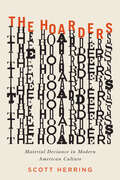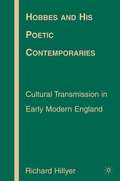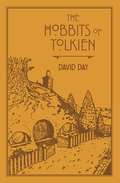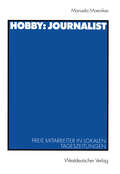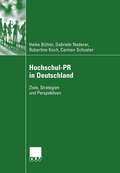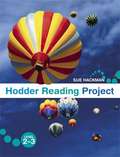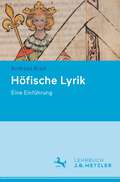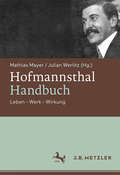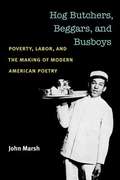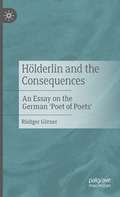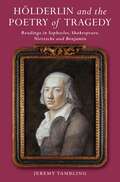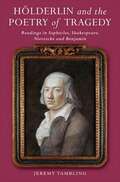- Table View
- List View
The Hoarders: Material Deviance in Modern American Culture
by Scott HerringThe verb “declutter” has not yet made it into the Oxford English Dictionary, but its ever-increasing usage suggests that it’s only a matter of time. Articles containing tips and tricks on how to get organized cover magazine pages and pop up in TV programs and commercials, while clutter professionals and specialists referred to as “clutterologists” are just a phone call away. Everywhere the sentiment is the same: clutter is bad. In The Hoarders, Scott Herring provides an in-depth examination of how modern hoarders came into being, from their onset in the late 1930s to the present day. He finds that both the idea of organization and the role of the clutterologist are deeply ingrained in our culture, and that there is a fine line between clutter and deviance in America. Herring introduces us to Jill, whose countertops are piled high with decaying food and whose cabinets are overrun with purchases, while the fly strips hanging from her ceiling are arguably more fly than strip. When Jill spots a decomposing pumpkin about to be jettisoned, she stops, seeing in the rotting, squalid vegetable a special treasure. “I’ve never seen one quite like this before,” she says, and looks to see if any seeds remain. It is from moments like these that Herring builds his questions: What counts as an acceptable material life—and who decides? Is hoarding some sort of inherent deviation of the mind, or a recent historical phenomenon grounded in changing material cultures? Herring opts for the latter, explaining that hoarders attract attention not because they are mentally ill but because they challenge normal modes of material relations. Piled high with detailed and, at times, disturbing descriptions of uncleanliness, The Hoarders delivers a sweeping and fascinating history of hoarding that will cause us all to reconsider how we view these accumulators of clutter.
The Hoarders: Material Deviance in Modern American Culture
by Scott HerringThe verb “declutter” has not yet made it into the Oxford English Dictionary, but its ever-increasing usage suggests that it’s only a matter of time. Articles containing tips and tricks on how to get organized cover magazine pages and pop up in TV programs and commercials, while clutter professionals and specialists referred to as “clutterologists” are just a phone call away. Everywhere the sentiment is the same: clutter is bad. In The Hoarders, Scott Herring provides an in-depth examination of how modern hoarders came into being, from their onset in the late 1930s to the present day. He finds that both the idea of organization and the role of the clutterologist are deeply ingrained in our culture, and that there is a fine line between clutter and deviance in America. Herring introduces us to Jill, whose countertops are piled high with decaying food and whose cabinets are overrun with purchases, while the fly strips hanging from her ceiling are arguably more fly than strip. When Jill spots a decomposing pumpkin about to be jettisoned, she stops, seeing in the rotting, squalid vegetable a special treasure. “I’ve never seen one quite like this before,” she says, and looks to see if any seeds remain. It is from moments like these that Herring builds his questions: What counts as an acceptable material life—and who decides? Is hoarding some sort of inherent deviation of the mind, or a recent historical phenomenon grounded in changing material cultures? Herring opts for the latter, explaining that hoarders attract attention not because they are mentally ill but because they challenge normal modes of material relations. Piled high with detailed and, at times, disturbing descriptions of uncleanliness, The Hoarders delivers a sweeping and fascinating history of hoarding that will cause us all to reconsider how we view these accumulators of clutter.
Hobbes and His Poetic Contemporaries: Cultural Transmission in Early Modern England
by R. HillyerRanging from Jonson to Rochester and including several critically neglected figures, select poetic contemporaries variously illuminate the scope of Hobbes's writing and the reach of his influence, in turn shedding diverse lights on the nature of their own work.
The Hobbit Companion
by David DayExploring the brilliant web of verbal hocus-pocus that J.R.R. Tolkien delightedly spun in The Hobbit and The Lord of the Rings, master hobbit investigator David Day reveals the myriad crafty puns and riddles, hidden meanings, and mythical associations beneath the saga's thrilling surface.
The Hobbits of Tolkien (Tolkien Illustrated Guides #6)
by David DayAn entire race was born when J.R.R. Tolkien scrawled on a leaf, 'In a hole in the ground there lived a hobbit.' From the invention of that single word (hobbit) Tolkien became the explorer and chronicler of the character, their race and their significant role in his fantastical world, Middle-earth.Here in his latest book, Tolkien expert David Day unpicks the myriad of riddles, puns and mystical meanings in Tolkien's works; The Hobbit and The Lord of the Rings.
Hobby: Freie Mitarbeiter in lokalen Tageszeitungen (Journalistik: Forschungsimpulse für die Praxis)
by Monika MoenikesDie freien Mitarbeiter, besonders die nebenberuflichen, werden oft vernachlässigt und wie "Wasserträger" des Journalismus behandelt - zu Unrecht, denn freie Mitarbeiter füllen bis zu zwei Drittel der lokalen Zeitungsseiten. Darum läßt sich durch eine gezielte Betreuung der Freien das Niveau eines Blattes deutlich verbessern. Die Autorin hat am Beispiel einer Lokalzeitung untersucht, wie die "Freien" arbeiten und was sie über den Journalismus wissen. Sie analysiert die Artikel der "Hobbyjournalisten" unter Qualitätsgesichtspunkten. Auf der Basis ihrer Analyse hat die Autorin einen Qualifizierungs-Workshop für freie Mitarbeiter konzipiert, der sich bereits in der Praxis bewährt hat. Dieses Seminar wird ausführlich vorgestellt, so daß es Lokalredakteuren als Anregung dienen kann.
Hochon's Arrow: The Social Imagination of Fourteenth-Century Texts
by Paul Strohm"The paradox of the lie that might as well be true," writes Paul Strohm, "must interest anyone who seeks to understand texts in history or the historical influence of texts." In these seven essays, all recent and most published here for the first time, the author examines historical and literary texts from fourteenth-century England. He not only demonstrates the fictionality of narrative and documentary sources, but also argues that these fictions are themselves fully historical. Together the essays institute a dialogue between texts and events that restores historical documents and literary works to their larger environments. Strohm begins by inspecting legal records that accuse Hochon of Liverpool in 1384 of threatening to shoot an arrow at a political adversary urinating against a wall, and shows how the text embodies and interconnects language, social space, and historical interpretation itself. Throughout his analyses, which cover such topics as Chaucer's verses on the accession of Henry IV, Froissart's account of Queen Philippa interceding for the burghers of Calais, and Thomas Usk's accusations against John Northampton, Strohm alerts us to the distortions of textuality itself while challenging our notions of "invented" and "true."Originally published in 1992.The Princeton Legacy Library uses the latest print-on-demand technology to again make available previously out-of-print books from the distinguished backlist of Princeton University Press. These editions preserve the original texts of these important books while presenting them in durable paperback and hardcover editions. The goal of the Princeton Legacy Library is to vastly increase access to the rich scholarly heritage found in the thousands of books published by Princeton University Press since its founding in 1905.
Hochschul-PR in Deutschland: Ziele, Strategien und Perspektiven
by Heike Bühler Gabriele Naderer Robertine Koch Carmen SchusterHeike Bühler, Gabriele Naderer, Robertine Koch und Carmen Schuster untersuchen, inwieweit die Presse- und Öffentlichkeitsarbeit an deutschen Hochschulen deren neuen Aufgaben wie Internationalisierung, Alumni-Arbeit und Networking, Werben um Sponsoren und um die besten Studierenden und Professoren Rechnung trägt. Dies wird analysiert im Kontext der personellen und finanziellen Situation sowie in Abhängigkeit von der strategischen Ausrichtung.
Hodder Group Reading Test 2A (PDF)
by Denis Vincent Mary CrumplerThe Hodder Group Reading Tests 1-3 assess pupils' reading comprehension at word, sentence and text levels. They are designed as wide-range tests, and thus are especially useful in screening and monitoring mixed-ability groups where some pupils may be much more advanced, or much slower, than the average. The Hodder Group Reading Tests 1-3 all have parallel forms A and B, for use with the following age groups: Test 1 - ages 5:0 to 9:0 (Years 1 to 3); Test 2 - ages 7:0 to 12:0 (Years 2 to 6); Test 3 - ages 9:5 to 16+ (Years 5 to 11) Each test takes about 30 minutes to administer to whole class or year groups: the parallel forms A and B can be used simultaneously to minimise copying, as well as to assess progress over time. At each level, the tests include questions which assess pupil's understanding of word meanings, culturally neutral sentence-completion questions, and higher-level 'cloze' tasks that require pupils to both comprehend and reflect upon the content and the context of continuous text. Dependable norms express performance as standardised scores, reading ages and national curriculum levels.
Hodder Group Reading Test 3A (PDF)
by Denis Vincent Mary CrumplerThe Hodder Group Reading Tests 1-3 assess pupils' reading comprehension at word, sentence and text levels. They are designed as wide-range tests, and thus are especially useful in screening and monitoring mixed-ability groups where some pupils may be much more advanced, or much slower, than the average. The Hodder Group Reading Tests 1-3 all have parallel forms A and B, for use with the following age groups: Test 1 - ages 5:0 to 9:0 (Years 1 to 3); Test 2 - ages 7:0 to 12:0 (Years 2 to 6); Test 3 - ages 9:5 to 16+ (Years 5 to 11) Each test takes about 30 minutes to administer to whole class or year groups: the parallel forms A and B can be used simultaneously to minimise copying, as well as to assess progress over time. At each level, the tests include questions which assess pupil's understanding of word meanings, culturally neutral sentence-completion questions, and higher-level 'cloze' tasks that require pupils to both comprehend and reflect upon the content and the context of continuous text. Dependable norms express performance as standardised scores, reading ages and national curriculum levels.
Hodder Group Reading Test 3B (PDF)
by Denis Vincent Mary CrumplerThe Hodder Group Reading Tests 1-3 assess pupils' reading comprehension at word, sentence and text levels. They are designed as wide-range tests, and thus are especially useful in screening and monitoring mixed-ability groups where some pupils may be much more advanced, or much slower, than the average. The Hodder Group Reading Tests 1-3 all have parallel forms A and B, for use with the following age groups: Test 1 - ages 5:0 to 9:0 (Years 1 to 3); Test 2 - ages 7:0 to 12:0 (Years 2 to 6); Test 3 - ages 9:5 to 16+ (Years 5 to 11) Each test takes about 30 minutes to administer to whole class or year groups: the parallel forms A and B can be used simultaneously to minimise copying, as well as to assess progress over time. At each level, the tests include questions which assess pupil's understanding of word meanings, culturally neutral sentence-completion questions, and higher-level 'cloze' tasks that require pupils to both comprehend and reflect upon the content and the context of continuous text. Dependable norms express performance as standardised scores, reading ages and national curriculum levels.
Hodder Group Reading, Tests 1A (PDF)
by Denis Vincent Mary CrumplerThe Hodder Group Reading Tests 1-3 assess pupils' reading comprehension at word, sentence and text levels. They are designed as wide-range tests, and thus are especially useful in screening and monitoring mixed-ability groups where some pupils may be much more advanced, or much slower, than the average. The Hodder Group Reading Tests 1-3 all have parallel forms A and B, for use with the following age groups: Test 1 - ages 5:0 to 9:0 (Years 1 to 3); Test 2 - ages 7:0 to 12:0 (Years 2 to 6); Test 3 - ages 9:5 to 16+ (Years 5 to 11) Each test takes about 30 minutes to administer to whole class or year groups: the parallel forms A and B can be used simultaneously to minimise copying, as well as to assess progress over time. At each level, the tests include questions which assess pupil's understanding of word meanings, culturally neutral sentence-completion questions, and higher-level 'cloze' tasks that require pupils to both comprehend and reflect upon the content and the context of continuous text. Dependable norms express performance as standardised scores, reading ages and national curriculum levels.
Hodder Group Reading Tests 2B (PDF)
by Denis Vincent Mary CrumplerThe Hodder Group Reading Tests 1-3 assess pupils' reading comprehension at word, sentence and text levels. They are designed as wide-range tests, and thus are especially useful in screening and monitoring mixed-ability groups where some pupils may be much more advanced, or much slower, than the average. The Hodder Group Reading Tests 1-3 all have parallel forms A and B, for use with the following age groups: Test 1 - ages 5:0 to 9:0 (Years 1 to 3); Test 2 - ages 7:0 to 12:0 (Years 2 to 6); Test 3 - ages 9:5 to 16+ (Years 5 to 11) Each test takes about 30 minutes to administer to whole class or year groups: the parallel forms A and B can be used simultaneously to minimise copying, as well as to assess progress over time. At each level, the tests include questions which assess pupil's understanding of word meanings, culturally neutral sentence-completion questions, and higher-level 'cloze' tasks that require pupils to both comprehend and reflect upon the content and the context of continuous text. Dependable norms express performance as standardised scores, reading ages and national curriculum levels.
Hodder Reading Project Pupil Book Level 2-3 (PDF)
by Sue HackmanThe Hodder Reading Project provides an accelerated route for lower-attainers to catch up with their peers in reading. It giver clear support for teachers working with pupils whose reading levels are significantly below the national average. The Hodder Reading Project: Level 2-3 identifies blocks to progression and takes pupils from National Curriculum Level 2 to Level 3. It comprises the Teacher's Resource, Pupil's Book and 12 Readers. Pupil's Book: a full-colour, engaging textbook using a series of objective-linked masterclasses to introduce all the readings skills and strategies pupils need to progress to their next Level. Supported by the Teacher's Resource, it equips pupils to apply, consolidate and practise these reading skills and strategies with the Readers.
Hodder Reading Project Pupil Book Level 3-4 (Hodder Reading Project Ser.)
by Sue HackmanThe Hodder Reading Project provides an accelerated route for lower-attainers to catch up with their peers in reading. It giver clear support for teachers working with pupils whose reading levels are significantly below the national average. The Hodder Reading Project: Level 3-4 identifies blocks to progression and takes pupils from National Curriculum Level 3 to Level 4. It comprises the Teacher's Resource, Pupil's Book and 6 Readers Pupil's Book: a full-colour, engaging textbook using a series of objective-linked masterclasses to introduce all the readings skills and strategies pupils need to progress to their next Level. Supported by the Teacher's Resource, it equips pupils to apply, consolidate and practise these reading skills and strategies with the Readers.
Höfische Lyrik: Eine Einführung
by Andreas KraßMinnesang, Sangspruch und Leich – die drei Hauptgattungen der deutschsprachigen Lyrik des Hochmittelalters stehen im Zentrum dieser Einführung. Der erste Teil behandelt die kulturgeschichtlichen und politischen Voraussetzungen sowie die form- und gattungsgeschichtlichen Entwicklungen. Ein besonderes Augenmerk liegt dabei auf der kulturellen Konstruktion der Geschlechterrollen und Liebeskonzepte. Der zweite Teil bietet zahlreiche Interpretationen zu konkreten Fallbeispielen aus allen drei Gattungen der höfischen Lyrik und führt so in die Praxis der Textanalyse ein. Kapitel zur Überlieferungs- und Editionsgeschichte sowie ein weiterführendes Literaturverzeichnis runden den Band ab.
Hofmannsthal: Three Essays
by Michael HamburgerContents: Poems and Verse Plays; Plays and Libretti; Hofmannsthal's Debt to the English-speaking WorldOriginally published in 1973.The Princeton Legacy Library uses the latest print-on-demand technology to again make available previously out-of-print books from the distinguished backlist of Princeton University Press. These editions preserve the original texts of these important books while presenting them in durable paperback and hardcover editions. The goal of the Princeton Legacy Library is to vastly increase access to the rich scholarly heritage found in the thousands of books published by Princeton University Press since its founding in 1905.
Hofmannsthal-Handbuch: Leben - Werk - Wirkung
Hugo von Hofmannsthal, Europäer und Wiener, Lyriker und raffinierter Erzähler, erfolgreicher und manchmal packend gescheiterter Dramatiker, weltoffener Essayist und unbequemer Zeitgenosse, sprachmächtiger Sprachskeptiker im Brief des Lord Chandos dieses Handbuch beleuchtet die schwer überschaubare Vielseitigkeit des Werkes in seinen ideen- und kulturgeschichtlichen Verschränkungen. Erträge der Forschung und der Editionen werden zu Perspektiven gebündelt, die eine komplexe Gestalt der Moderne als Spiegel darüber hinausreichender Fragen zeigen.
Hofmannsthal's Novel "Andreas": Memory and Self
by David H. MilesAlthough Hofmannsthal never completed his only novel Andreas, its theme—the quest for self through memory—haunted the Viennese writer and recurs again and again in his poems, libretti, and essays. Analyzing the fragment, David Miles discusses Hofmannsthal's understanding of memory and myth, Andreas' pivotal role in his work, and its place within the tradition of such novels as Goethe's Wilhelm Meister and Rilke's Malte.Originally published in 1972.The Princeton Legacy Library uses the latest print-on-demand technology to again make available previously out-of-print books from the distinguished backlist of Princeton University Press. These editions preserve the original texts of these important books while presenting them in durable paperback and hardcover editions. The goal of the Princeton Legacy Library is to vastly increase access to the rich scholarly heritage found in the thousands of books published by Princeton University Press since its founding in 1905.
Hog Butchers, Beggars, And Busboys: Poverty, Labor, And The Making Of Modern American Poetry (Class : Culture Ser. (PDF))
by John MarshImpressive—Marsh successfully rewrites the founding moment of American Modernist poetry. ---Mark Van Wienen, Northern Illinois University ""Cogently argued, instructive, and sensitive, Marsh's revisionist reading opens new insights that will elicit lively comment and critical response."" ---Douglas Wixson, University of Missouri–Rolla Between 1909 and 1922, the genre of poetry was remade. Literary scholars have long debated why modern American poetry emerged when and how it did. While earlier poetry had rhymed, scanned, and dealt with conventional subjects such as love and nature, modern poetry looked and sounded very different and considered new areas of experience. Hog Butchers, Beggars, and Busboys: Poverty, Labor, and the Making of Modern American Poetry argues that this change was partially the result of modern poets writing into their verse what other poetry had suppressed: the gritty realities of modern life, including the problems of the poor and working class. A closer look at the early works of the 20th century's best known poets (William Carlos Williams, T. S. Eliot, Edna St. Vincent Millay, Claude McKay, Langston Hughes, and Carl Sandburg) reveals the long-neglected role the labor problem—including sweatshops, strikes, unemployment, woman and child labor, and immigration---played in the formation of canonical modern American poetry. A revisionary history of literary modernism and exploration into how poets uniquely made the labor problem their own, this book will appeal to modernists in the fields of American and British literature as well as scholars in American studies and the growing field of working-class literature.
Hogfather (Modern Plays)
by Terry PratchettIt's the night before Hogswatch. And it's too quiet. Superstition makes things work in the Discworld, and undermining it can have consequences. It's just not right to find Death creeping down chimneys and trying to say 'Ho Ho Ho…'It's the last night of the year, the time is turning, and if Susan, gothic governess and Death's granddaughter (sort of), doesn't sort everything out by morning, there won't be a morning. Ever again…Adapted by Terry Pratchett's long-time collaborator Stephen Briggs, this play text version of Pratchett's bestselling Discworld novel Hogfather wittily and faithfully reimagines the story for the stage.
Hogfather (Modern Plays)
by Terry PratchettIt's the night before Hogswatch. And it's too quiet. Superstition makes things work in the Discworld, and undermining it can have consequences. It's just not right to find Death creeping down chimneys and trying to say 'Ho Ho Ho…'It's the last night of the year, the time is turning, and if Susan, gothic governess and Death's granddaughter (sort of), doesn't sort everything out by morning, there won't be a morning. Ever again…Adapted by Terry Pratchett's long-time collaborator Stephen Briggs, this play text version of Pratchett's bestselling Discworld novel Hogfather wittily and faithfully reimagines the story for the stage.
Hölderlin and the Consequences: An Essay on the German 'Poet of Poets'
by Rüdiger Görner"A sign we are, uninterpreted. Painless we are and have almost / lost the language in a foreign country." Thus begins the second version of Friedrich Hölderlin's hymn dedicated to goddess of memory, Mnemosyne. "Hölderlin and the Consequences" wants to remember this 'poet of poets' and consider what his unmatched poems have stimulated, even triggered, in others. This scholarly essay examines the legacy of a poet who was, by and large, ostracized in his time, a master of language, who was declared a stranger by his contemporaries until he became a stranger to himself. Hölderlin's multiple experience of foreignness and alienation was later counteracted by often ideologically motivated attempts to appropriate him. Rüdiger Görner presents this complex context as a special case in recent literary history.This book is a translation of an original German 1st edition, "Hölderlin und die Folgen" by Rüdiger Görner, published by J.B. Metzler, imprint of Springer-Verlag GmbH Germany, part of Springer Nature in 2016. The translation was done with the help of artificial intelligence (machine translation by the service DeepL.com). The author (with the support of Josh Torabi) has subsequently revised the text further in an endeavour to refine the work stylistically.
Hölderlin and the Poetry of Tragedy: Readings in Sophocles, Shakespeare, Nietzsche and Benjamin
by Jeremy TamblingHölderlin (1770-1843) is the magnificent writer whom Nietzsche called 'my favourite poet'. His writings and poetry have been formative throughout the twentieth century, and as influential as those of Hegel, his friend. At the same time, his madness has made his poetry infinitely complex as it engages with tragedy, and irreconcilable breakdown, both political and personal, with anger and with mourning. This study gives a detailed approach to Hölderlin's writings on Greek tragedy, especially Sophocles, whom he translated into German, and gives close attention to his poetry, which is never far from an engagement with tragedy. Hölderlin's writings, always fascinating, enable a consideration of the various meanings of tragedy, and provide a new reading of Shakespeare, particularly Julius Caesar, Hamlet and Macbeth; the work proceeds by opening into discussion of Nietzsche, especially The Birth of Tragedy. Since Hölderlin was such a decisive figure for Modernism, to say nothing of modern Germany, he matters intensely to such differing theorists and philosophers as Walter Benjamin, Theodor Adorno, Martin Heidegger, Maurice Blanchot and Jacques Derrida, all of whose views are discussed herein. Drawing upon the insights of Hegelian philosophy and psychoanalysis, this book gives the English-speaking reader ready access to a magnificent body of poetry and to the poet as a theorist of tragedy and of madness. Hölderlin's poetry is quoted freely, with translations and commentary provided. This book is the first major account of Hölderlin in English to offer the student and general reader a critical account of a vital body of work which matters to any study of poetry and to all who are interested in poetry's relationships to madness. It is essential reading in the understanding of how tragedy pervades literature and politics, and how tragedy has been regarded and written about, from Hegel to Walter Benjamin.
Hölderlin and the Poetry of Tragedy: Readings in Sophocles, Shakespeare, Nietzsche and Benjamin
by Jeremy TamblingHölderlin (1770-1843) is the magnificent writer whom Nietzsche called 'my favourite poet'. His writings and poetry have been formative throughout the twentieth century, and as influential as those of Hegel, his friend. At the same time, his madness has made his poetry infinitely complex as it engages with tragedy, and irreconcilable breakdown, both political and personal, with anger and with mourning. This study gives a detailed approach to Hölderlin's writings on Greek tragedy, especially Sophocles, whom he translated into German, and gives close attention to his poetry, which is never far from an engagement with tragedy. Hölderlin's writings, always fascinating, enable a consideration of the various meanings of tragedy, and provide a new reading of Shakespeare, particularly Julius Caesar, Hamlet and Macbeth; the work proceeds by opening into discussion of Nietzsche, especially The Birth of Tragedy. Since Hölderlin was such a decisive figure for Modernism, to say nothing of modern Germany, he matters intensely to such differing theorists and philosophers as Walter Benjamin, Theodor Adorno, Martin Heidegger, Maurice Blanchot and Jacques Derrida, all of whose views are discussed herein. Drawing upon the insights of Hegelian philosophy and psychoanalysis, this book gives the English-speaking reader ready access to a magnificent body of poetry and to the poet as a theorist of tragedy and of madness. Hölderlin's poetry is quoted freely, with translations and commentary provided. This book is the first major account of Hölderlin in English to offer the student and general reader a critical account of a vital body of work which matters to any study of poetry and to all who are interested in poetry's relationships to madness. It is essential reading in the understanding of how tragedy pervades literature and politics, and how tragedy has been regarded and written about, from Hegel to Walter Benjamin.
